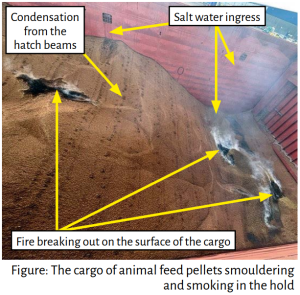In its latest Safety Digest, UK MAIB references a case in which a bulk carrier’s cargo of animal feed pellets caught fire due to water ingress and condensation.
Arriving in the harbor late at night, the crew of a bulk carrier prepared to offload their cargo of loose animal feed pellets the following morning. The pellets were an International Maritime Solid Bulk Cargoes Code Group C cargo, classified as neither a liquefaction nor a chemical hazard, and had low inherent fire risk when dry. Weather conditions were cold but dry when the first loads of cargo were taken ashore.

Sometime later, the stevedores noticed that some of the cargo was wet and very warm. On checking the warehouse, they found that some of the pellets had started to burn, and these were quickly broken up and extinguished. An investigation of the hold revealed small areas of damp cargo that were smoking, which were removed to the quayside and dealt with. Cargo operations were suspended to allow surveyors to board and assess the situation.
Testing revealed that the cargo had suffered an ingress of saltwater, indicating that the holds had probably suffered a leak at sea. The ship had encountered very rough seas two days before arrival, which was a likely cause. However, significant condensation dripping from the hatch cover beams was also observed. Once wet, this cargo could start to ferment, heat up, and catch fire.
When the cargo hold hatches were opened, a large cloud of smoke was seen. The cargo was smoldering heavily in places. Crews from the local fire services, a tug equipped with a fire monitor, and the ship’s crew worked together to fight the fire. Unfortunately, approximately 40% of the cargo was destroyed.
Lessons learned
Risk: Some bulk cargoes present a fire risk when damp. In addition to ensuring the cargo is in good condition before loading, it is vital to load in dry weather. It’s important to consider the fire risk from damp cargo by having appropriate ventilation control, atmosphere monitoring, and temperature checks in place. These measures help ensure the cargo reaches its destination in good condition, keeping the ship and its crew safe.
Maintain: Well-maintained and properly sealed hatch coamings provide the best protection against water ingress during bad weather. Poor maintenance and ineffective seals can lead to water leaking into the cargo, increasing the risk of fire.
Plan: A fire in the hold can be a serious threat to the safety of the entire ship and its crew, especially at sea. It’s essential to have a carefully considered, well-rehearsed plan to deal with any such event.

































































